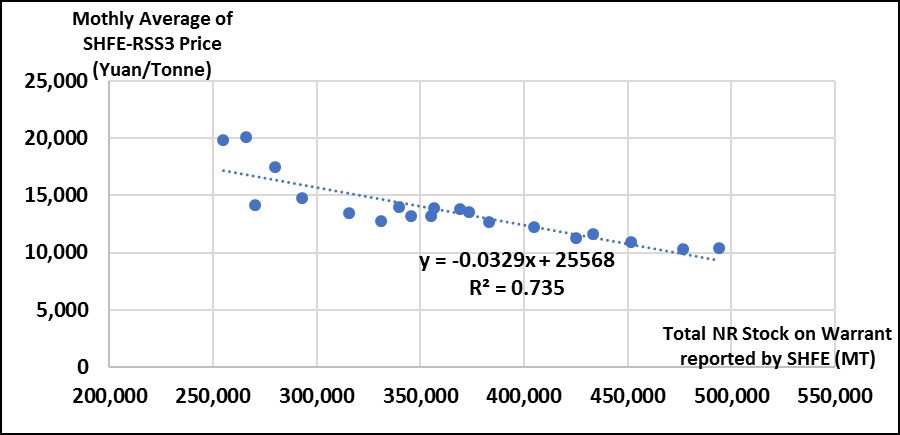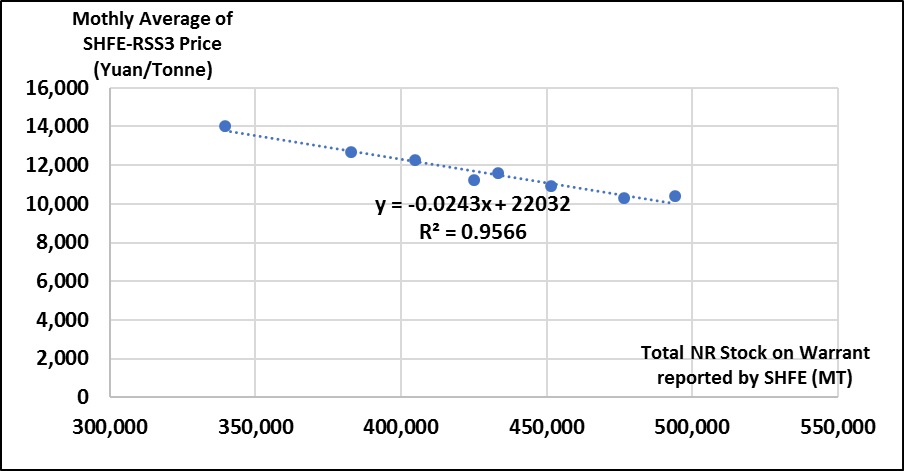The analysis comprises the relationship between the NR stock and price in SHFE, the level of NR stock in Qingdao as compared to China’s monthly NR consumption and the importance of sustainable NR supply to meet the consumption.
1) The Relationship between the NR Stock and Price in SHFE:
SHFE NR Stock Increases but It Is Not Meant for Tyre Sector
Daily Composite Price (DCP) of NR reported by International Rubber Consortium (IRCo) is hovering in a low and tight level since Mid-June 2018. Market views that any change of NR stock level in SHFE has direct impact to the market sentiment and prices.
NR stock in SHFE keeps rising from 313,800 MT in the beginning of 2018 to its historical high level of 551,634 MT as at end of 31 August 2018. To enable us to see the relationship between the movement of NR price on SHFE and its stock level, IRCo has analysed the correlation of two mentioned factors as shown in chart 1 below:
Chart 1. The Correlation between the Monthly Average Price of RSS3 (M3) on SHFE and the Total NR Stock on Warrant level as reported by SHFE from January 2017 – August 2018

Analysis by IRCo, 12 September 2018
Data Source: Thompson Reuters
The above chart shows the high inverse correlation between NR price and total NR stock level during January 2017 to August 2018, with correlation level of 73.5% (R2 = 0.735).
The high correlation between SHFE price and stock level is more significant in 2018. Our analysis shows a significant inverse correlation level of 95.66% (R2 = 0.9566) between NR price on SHFE and its stock level as shown in chart 2:
Chart 2. The Correlation between the Monthly Average Price of RSS3 (M3) on SHFE and the Total NR Stock on Warrant level as reported by SHFE from January – August 2018

Source: IRCo, 12 September 2018
However, IRCo views that the SHFE NR stocks level which are mainly in the form of Standard China Rubber-Whole Field (SCR-WF) and this grade is not tyre grade of Technically Specified Rubber 20 (TSR20), hence it should not have direct impacts to market sentiment.
In addition to that, the main users of this type of NR grade are non-tyre manufacturers with a yearly consumption of about 150,000 MT. (Source: Market Commentary by Chief Executive Officer (CEO) of Halcyon “What is Wrong with the Natural Rubber Market, on 16 August 2018).
2) The Level of NR stock in Qingdao as Compared to China’s Monthly NR Consumption:
Qingdao NR Stock (mainly TSR20 grade) Decreases in 2018 : should have positive impacts to physical rubber market sentiment
On the other hand, NR stock in Qingdao which is more reflective to NR industry particularly in tyre industry and the stock level shows a significant decrease from 130,800 MT as at end of December 2017 to only 77,200 MT as at end 16 August 2018.
Furthermore, when we compare the increasing trend of NR consumption in China with the declining trend of NR stock in Qingdao, we were of the view that the situation is critical and demand attention from Chinese manufacturers as the stock is merely enough for 5 days use. The movement of NR stocks level in Qingdao and monthly average of China NR consumption is shown in table 1.
Table 1. The Movement of NR stocks in Qingdao (as at end of the period) and Monthly Average of China NR Consumption from 2018 – August 2018
Source: Thompson Reuters and Association of Natural Rubber Producing Countries (ANRPC) and calculated by IRCo, 12 September 2018
IRCo was of the view that the critical low of NR stock level in Qingdao could be a big risk for China rubber and tyre manufacturers in the event of any unexpected shortage in the near future.
NR is a crop which may be affected by erratic weather conditions such as floods in Kerala India as well as Southern Thailand and Northern Peninsular Malaysia at the end of each year. Furthermore, smallholders particularly those who have other economic activities as alternative source of income may abandon tapping if NR price continues hovering at low level.
3) The Importance of Sustainable NR Supply to Meet the Consumption:
China Rubber Industry Needs Sustainable and Secure NR Supply
For the first 7 months of 2018, ANRPC reported that China’s total NR consumption increased by 2.8% to 3.228 million MT as compared to 3.139 million MT during the same period of 2017.
For the whole of 2018, ANRPC estimated that the China NR consumption would increase by 6.2% to 5.720 million MT as compared to 5.386 million MT in 2017. The improvement of NR consumption in 2018 is shown in table 2 below:
Table 2. Actual China NR Consumption from January – July 2018 and Projection for the Whole Year of 2018
Source: ANRPC (NR Statistics and Trends), July Bulletin 2018
The increase in NR demand by China needs equal supply of NR which is mainly imported from other producing countries. Therefore, it is important for consumers especially China manufacturers to manage stock properly to secure raw material for their industry.
IRCo has a strong view that it is an utmost essential for NR consumers to closely collaborate and work hand-in-hand with producers (mainly NR farmers) to ensure the prices are at a remunerative level, that will also ensure an adequate supply to rubber industry in the future.
